

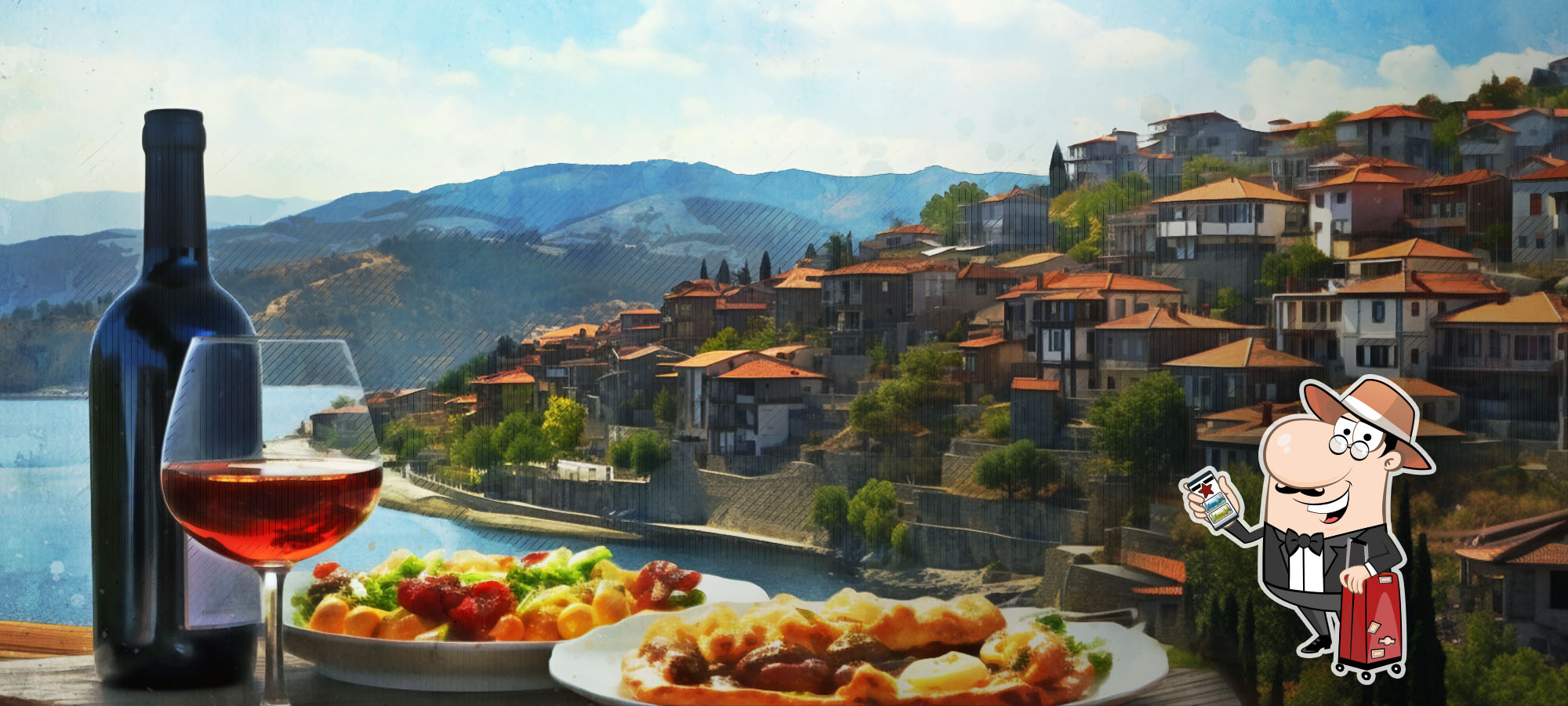
The total area of North Macedonia is 25,713 square kilometers, or 9,928 square miles. To put this into perspective, it is approximately 10 times greater than the area of Luxembourg, but 5 times smaller than that of Greece, and France can accommodate roughly 20 North Macedonias. Yet, this small European country – only 150 kilometers across, east to west – recorded a 25% tourism turnover increase in 2023 (in monetary terms). So, why do people come here?
First off, North Macedonia is ancient: its history began with the kingdom of Paeonia around the 6th century BC. For those who like exploring very old buildings (and/or their ruins), which the country counts over a hundred of, this spells paradise. Secondly, this isn’t a developed industrial nation, which translates into untouched nature and carefully preserved gifts thereof. Thirdly, it is a gastronomic wonderland that, through the centuries, absorbed and processed culinary influences from its neighbors and produced something rather unique.
This guide gives you 8 dishes and 1 beverage you want to eat/drink in Macedonia, plus one (strong) traditional beverage. As mentioned above, the country isn’t large, so we’ve picked suggested restaurants in towns you’re likely to visit on a more or less typical North Macedonia exploration trip. Do let us know in the comments if there’s anything essential to the spirit of the country we should add to the piece!

It's a tasty nutritious dish consisting of tenderly cooked beans that are parboiled and then baked in a pot at a low temperature. Onions, bell peppers and other vegetables are added and steamed as well.
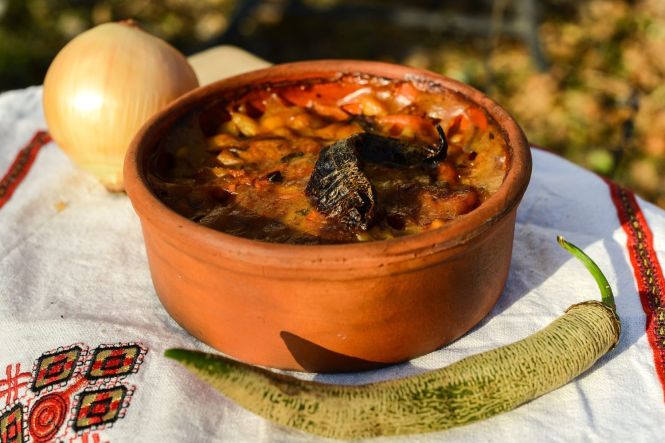 Tavče gravče, Macedonian bean stew to eat in Skopje. Image by Oliver Manev. Licence CC BY-SA 4.0. Cropped from original
Tavče gravče, Macedonian bean stew to eat in Skopje. Image by Oliver Manev. Licence CC BY-SA 4.0. Cropped from original
Tavče gravče is, hands down, the national dish of North Macedonia. This is a somewhat strange turn of events, since this country, same as its Balkan brethren, knows how to grill meat, and tavče gravče is a hearty vegetarian stew. Logically, it makes sense, since beans have always been more readily available than meat. On an emotional level, this dish is like a warm embrace that comes at the right moment: white beans simmered with onions, peppers, and spices, baked in a clay pot for that final touch. Nutritionally, it's packed with protein and fiber, nothing healthy lifestyle disciples could complain about. Plus, you don’t need a can opener to enjoy it!
Similar to dishes like Spain’s fabada or Italy’s fagioli al forno, tavče gravče is significant for its role in family gatherings, often served on Fridays when meat is traditionally not consumed. If you’re ever invited to a Macedonian dinner, expect this dish to be the star of the show.
Skopje is where your vacation in North Macedonia starts, unless you’re on a road trip that takes you through several European countries. Quick facts about the country’s capital:
– Skopje's history stretches back over 7,000 years, with Neolithic ruins discovered in the area;
– the original name of the city was Scupi, and it was an important center during the Roman Empire;
– throughout its tumultuous history, Skopje has been influenced by various cultures and empires, including the Paionians, Dardanians, Byzantines, Bulgarians, Serbs, and Ottomans.
These, as you understand, are not just facts but factors that have shaped everything about the city and the country in general, including its cuisine. There are many authentic restaurants here that can give you a taste thereof; for tavče gravče, we suggest Gurman (address: Mother Teresa 6), a place better known to locals than tourists, which is always a good thing.

Ajvar means caviar in Turkish, it's a side dish that is very popular in Southeastern Europe. True ajvar is made of red bell peppers, salt, oil and vinegar. Peppers are roasted on an open fire and then cut into small pieces and stewed for several hours.
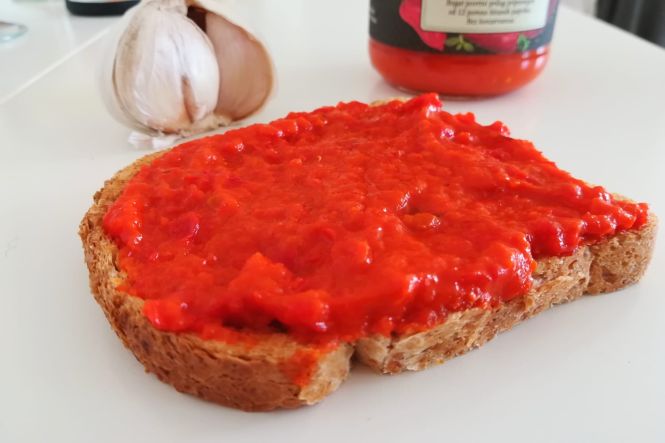 Ajvar, pepper spread to try in Macedonia. Image by Popo le Chien. Licence CC0. Cropped from original
Ajvar, pepper spread to try in Macedonia. Image by Popo le Chien. Licence CC0. Cropped from original
Ajvar is a red pepper spread that, for Macedonians, is not just a condiment but practically a national treasure, despite the fact that it is not a unique concept but one of the realizations of a moderately popular one (such as muhammara from Syria or romescu of Spain). The reason is simple: the dish makes the vegetables that constitute it play together so well the whole deal is simply irresistible. Not to mention that you can always get those ingredients in a country with ish agricultural traditions, which North Macedonia is.
Made primarily from roasted red peppers, eggplants, garlic, and chili, ajvar is an embodiment of the Ottoman influences. It is a carrier of taste, i.e., there are few calories in the spread itself, so the typical way to consume it is on top of a piece of bread (for reference, North Macedonia’s national bread is pogacha) or as a dip.
Continuing with Skopje: did you know that the city was under Ottoman rule for several centuries, from 1392 to 1913? And back then, it was called Üsküb. No wonder you can feel the breath of the past empire everywhere in the city. The above-described ajvar also has roots in that time, same as the way of enjoying it with bread. Given this, it makes sense to eat ajvar in Skopje at a spot known for good pogacha and skilful chefs passionate about their nation’s culinary traditions. Lavče kaj Žuti at Borka Talevski 1000 is one of such establishments: it is a no-frills restaurant/brasserie located west of the beaten paths, typically filled with locals. A perfect place to explore the daily life of Skopje’s citizens and try their favorites.

Sarma means "to wrap" in Turkish. The dish consists of grapes leaves or cabbage rolls stuffed with minced lamb or beef and rice. It's very popular in a number of countries, including the Middle East and Southeastern European countries.
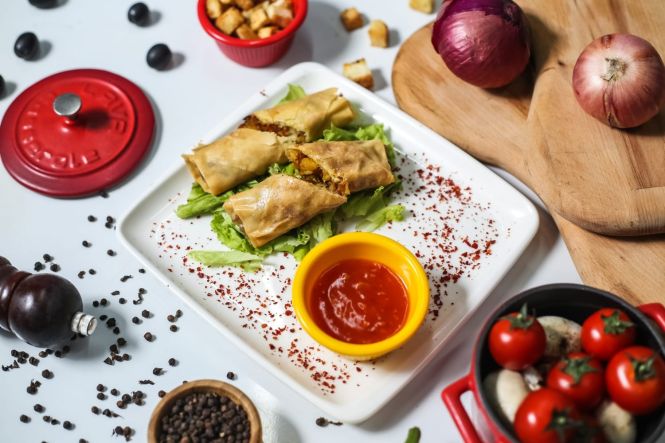 Sarma, stuffed cabbage rolls to eat in Macedonia. Image by stockking from Freepik
Sarma, stuffed cabbage rolls to eat in Macedonia. Image by stockking from Freepik
Sarma is like a cozy blanket you encounter and suddenly realize it’s chilly outside, a moment of joy filled with anticipation of something very pleasant about to happen. It is not exclusive to North Macedonia, of course: first jotted down in Ottoman cookbooks, the recipe is loved across the Balkans, with every nation adjusting it to its preferences or coming up with an alternative approach to the cooking process.
In North Macedonia, sarma is a wrapper of grape or cabbage leaves containing a savory filling of rice, minced meat (beef or pork), and assorted herbs and spices. There’s nothing pickled in this dish here, as opposed to Croatian variety, and the rolls are simmered slowly to render them tender and flavorful. Served with yogurt or sour cream, which enhance sarma’s richness and provide a refreshing contrast, the dish is an absolute must for a gourmet exploring North Macedonia.
Skopje stands on the banks of the Vardar River, and has mountainous terrain all around it. The climate here is warm, with hot summers and cold winters. This means that it’s always great to know a place in the city that’s got both outdoor and indoor seating areas. Restaurant Skopski Merak, an establishment boasting a Google Maps score of 4.6 at over 4,300 assessments, is one of those. If you have the zoo on your to-visit list, or the City Park, consider getting a table here and eating the fantastic sarma they’re wrapping.

This dish is a kind of ajvar cooked from eggplants and peppers that are baked and roasted for several hours. Pindjur is very popular in North Macedonia, Bulgaria, Serbia and Bosnia and Herzegovina.
 Pindjur, vegetable spread from Macedonia. Image by Kotle31. Licence CC BY-SA 4.0. Cropped from original
Pindjur, vegetable spread from Macedonia. Image by Kotle31. Licence CC BY-SA 4.0. Cropped from original
Pindjur is a festival of roasted vegetables blended into a smoky paste. A summer staple of North Macedonian cuisine, it is a delicious mix of tomatoes, bell peppers, eggplants, and garlic. Closely resembling the aforementioned ajvar, it differs therefrom in its core ingredient – tomatoes vs red peppers – and ultimate texture, with the former being a smooth spread and the latter a chunkier, salsa-like sauce.
Rich with vitamins and antioxidants, it pairs beautifully with grilled meats or bread. Pindjur is very popular in North Macedonia, Bulgaria, Serbia, and Bosnia and Herzegovina, and is a mandatory dish to eat especially when red peppers and tomatoes are harvested (summertime, basically). If you have already tried Bulgarian lutenica, Romanian zacusca, and/or Moroccan matbucha, and like the concept in general, do not miss pindjur.
Although as mentioned in the intro, North Macedonia is definitely on the upward trend in terms of inbound tourism, you can’t really say there’s a tourist trap in Skopje. The city is small, and people here are still sincerely hospitable, do not see every guest exclusively as a source of income (yes, Spain and Greece, these insinuations are about you). Thus, sightseeing in the historical center of Skopje, walking the magnificent Stone Bridge, feel free to sit at the table of any restaurant you see there. Need a hint anyway? Go to Restaurant Dion, a place known to serve exceptional Macedonian cuisine dishes, including pindjur.

It's a national Macedonian dish similar to pizza. Pastrmajlija is oval-shaped and it is cooked from dough and sliced dry lamb or sheep and is topped with eggs and pickled peppers.
 Pastrmajlija, Macedonian take on the pizza concept. Image by Ivan Zh. Licence CC BY-SA 4.0.Cropped from original
Pastrmajlija, Macedonian take on the pizza concept. Image by Ivan Zh. Licence CC BY-SA 4.0.Cropped from original
Pizza is great, right? If there’s something billions (yes, billions) of people can agree on, it’s that statement. But pizza can be a hundred different things, and one of them is pastrmajlija, a traditional Macedonian oval-shaped pastry that playfully reinvents the Italian masterpiece.
What makes pastrmajlija unique? The toppings, of course:
– tender chunks of pork, marinated and sautéed, seasoned with spices like paprika and garlic, and often cut into bite-sized pieces;
– whole eggs are cracked directly onto the dough after the pork has been arranged, baked until just set, adding richness and a creamy texture to the dish;
– a drizzle of olive oil that helps to achieve a golden, crispy crust;
– and post-baking garnishes of chopped fresh parsley and sometimes red pepper flakes for added flavor and color.
Salivating yet? There really is nothing like pastrmajlija in North Macedonia!
Exploring North Macedonia, you may pass through many small villages, admiring the views through the windshield of your car. One of them is Seti Nikole, located near the town of Veles. You may find yourself around here when traveling to Veles, a town rich in history and culture (the Archaeological Museum and the Old Bazaar are notable sights here), or Kokino Megalithic Observatory (dates back to the Bronze Age), or Lake Tikvesh. Regardless of the ultimate destination, do stop at Seti Nikole’s Meckuevska Kukja – Puje, which appears as Мечкуевска Куќа - Пуже on Google Maps, for authentic Macedonian food, including the glorified pastrmajlija.

This classic dish consists of large bell peppers filled with beef, rice, tomatoes and sauce. You can try a number of its recipes all over the world. Peppers are called "bell" because of their form.
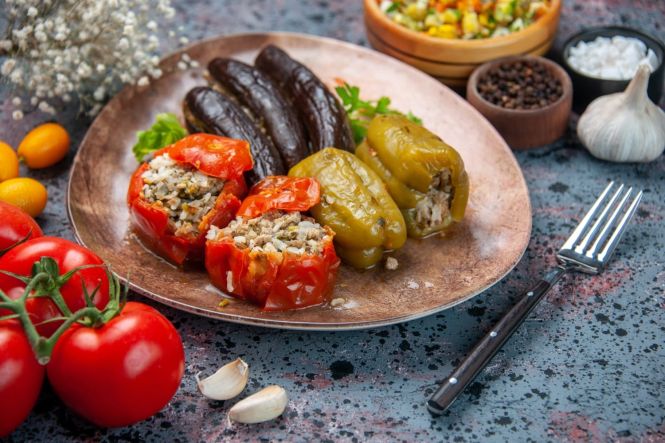 Polneti piperki, stuffed bell peppers to try in Macedonia. Image by mdjaff from Freepik
Polneti piperki, stuffed bell peppers to try in Macedonia. Image by mdjaff from Freepik
Stuffed peppers are a universal comfort food: filling, nutritious, and well-balanced in terms of health benefits, they hail from the childhood of every Macedonian, Greek, or representative of any Balkan nation as a dish their parents made for special occasions or to make a winter dinner exceptional. This emotional background inadvertently made an otherwise common recipe a gem in the crown of local cuisine.
In North Macedonia, polneti piperki are stuffed with minced meat (often a mix of pork and beef), rice, and a blend of herbs and spices like paprika, salt, and pepper. The rice is usually partially cooked before being mixed in. The preferred cooking method is baking, and while in an oven, the peppers swim in a red tomato sauce, which ultimately gives them a bit of acidity making the taste impossible to mistake for anything else. Enjoy!
On the way to Lake Ohrid, one of the must-visit places in North Macedonia, you may naturally come to Bitola, a town that’s got some sights and attractions of its own. The most prominent of those are Heraclea Lyncestis, an archaeological site, Magnolia Square and Clock Tower, and Bezisten, a covered bazaar that’s been in business since the 16th century. After the tour, find the Grne restaurant at Shirok Sokak 37, and enjoy a full Macedonian meal, including the delicious polneti piperki.
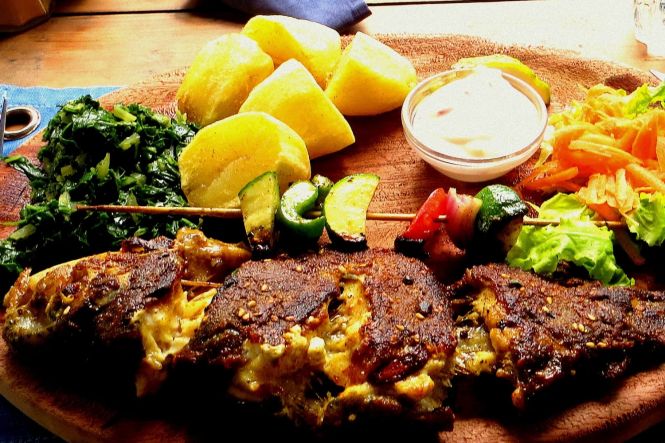 Ohrid trout, a delicious fish endemic to the Macedonian lake. Image by Shyqo. Licence CC BY-SA 4.0. Cropped from original
Ohrid trout, a delicious fish endemic to the Macedonian lake. Image by Shyqo. Licence CC BY-SA 4.0. Cropped from original
Ohrid trout isn’t just any fish; it's endemic to Lake Ohrid and, consequently, carries significant cultural importance in the eyes of the local population. The thing is, it’s quite prolific, and people living around the lake had to rely thereon as the key source of food quite often throughout the history of Macedonia.
The said importance, though, does not outshine the trout’s delicate flavor and tender texture, nor its nutritional value (it is high in omega-3 fatty acids). Grilled or baked, it is always seasoned to perfection in local taverns, which are numerous around the lake. If you’re not allergic to fish, this treat is not to be missed in North Macedonia.
Kaneo Restaurant & Letna Bavcha, Ohrid (address: Kocho Racin 43) is a restaurant in the town of Ohrid that stands right there on the shore of the famous Macedonian lake. Is there a better spot for lunch or dinner crowned with a locally sourced unique trout? There probably is, but we’re not aware of it. Thus, if you’re looking to eat national cuisine food and enjoy the views at the same time, the spot is quite perfect.

It is a national Macedonian and Balkan dish made from pork and mushrooms. Among other typical ingredients, you can find smoked meat, ground beef, tomatoes, onions, peppers and cream cheese that are baked in a clay pot.
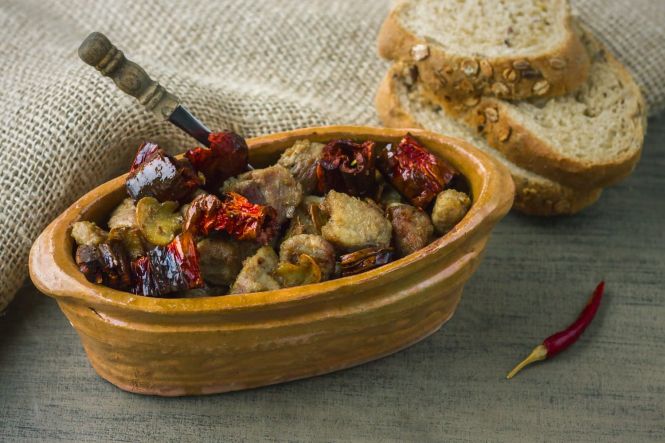 Selsko meso, hearty Macedonian meat stew. Image by MadMona. Licence CC BY-SA 4.0. Cropped from original
Selsko meso, hearty Macedonian meat stew. Image by MadMona. Licence CC BY-SA 4.0. Cropped from original
Imagine sitting down to a rustic stew that, with its looks alone, warms your soul. Colorful, emitting tantalizing aromas, luring you to dive in with a spoon. What your mind has just pictured is, most likely, closely resembles selsko meso, a traditional Macedonian stew that reflects the gratitude of locals to what Mother Nature endows them with.
This hearty meat stew typically includes pork or beef simmered with vegetables and sometimes red wine for depth of flavor. As is the case of most stews, the recipe is the fruit of the housewives’ unwillingness to let anything go to waste (no cuts are too thin for a stew!) Nutritionally, it is a protein and vegetables galore; often served during festive occasions or family gatherings, selsko meso is a great choice for a weary traveler looking to warm up on the inside as much as on the outside.
Utarna Terrace is a unique place: it is located in a tiny village of Gorno Konjsko, and, like the settlement, makes the steep slopes of this mountainous terrain a hospitable place. You may find it hard to reach, but the effort pays off brilliantly: the views are breathtaking, and the food, cooked by skilful owners, truly in love with their national cuisine, is incredibly good. Selsko meso is a highlight of the menu here, but it’s definitely not the only dish worth trying, so either come really hungry, or bring some friends to share your food with.

It's a popular Balkan fruit brandy. Rakia contains about 40% alcohol by volume. It's usually made from plums, peaches, cherries, apples and herbs.
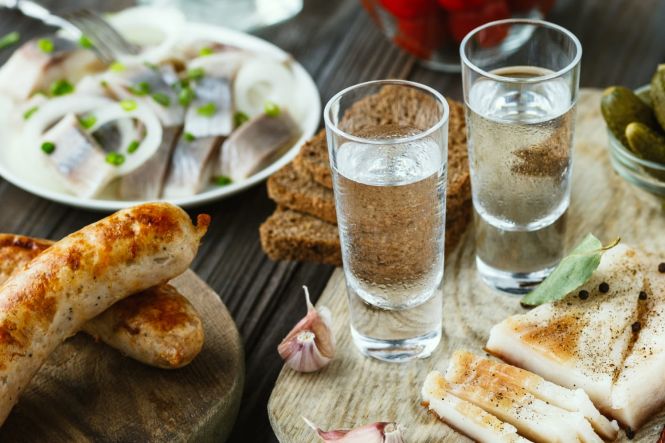 Rakija and chasers. Image by master1305 from Freepik
Rakija and chasers. Image by master1305 from Freepik
Rakija, fruit brandy usually made from grapes or plums, rounds out the culinary journey through North Macedonia. Balkan distilling traditions count centuries, so each sip (or shot) of rakija makes you a bit closer to the heritage carefully preserved through the centuries by thousands of people.
Rakija is typically served in small shot glasses, often accompanied by a selection of appetizers like cheese, cured meats, or salads. If a restaurant owner comes up with a plate filled as described in the previous sentence, do not refuse it: the amount won’t do anything to your perception of the world (in North Macedonia, the legal blood alcohol content (BAC) limit for driving is 0.05%), but the friendship you can strike with the guy is invaluable.
Rakija is available in pretty much every national cuisine restaurant in North Macedonia, and, if you like a shot of something strong and tasteful every now and then, or believe in digestives, your exploration of lore around this beverage will begin on the very first tavern you sit at in the country, regardless of what time of day it is. With this in mind, for rakija, we’ve decided to suggest a restaurant that may be off the beaten path – it is located in Mrzentsi, the southernmost municipality of Gevgelija, – but still boasts a Google Maps score of 4.7 at 2,300+ assessments, as of this writing. Why? Because this is an exceptional result for a catering establishment in North Macedonia outside of Skopje. If you happen to be there – crossing to Greece, for example – do pay Javor Agapi Mrzenci a visit, and don’t plan anything for the evening of that day.
If you’ve landed here looking for info about a potential vacation destination, we hope this guide added to the scales and made you more inclined to visit the discussed country. Really, as of this writing (fall 2024), the place is already well-developed in terms of tourist infrastructure, but not yet as popular as to be filled with crowds spoiling much of the fun a traveling gourmet is looking for. So, when you’ve tried everything we suggest above, do let us know in the comments which dish is your favorite now!

1 comment
Wow, North Macedonia seems like a hidden gem worth exploring! Can't wait to try tavče gravče and ajvar. Question for the author: What is the best beverage to pair with these delicious dishes?